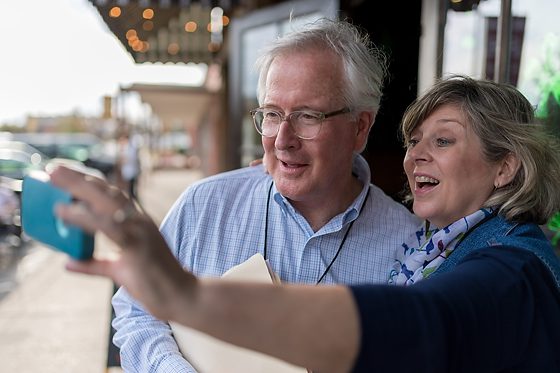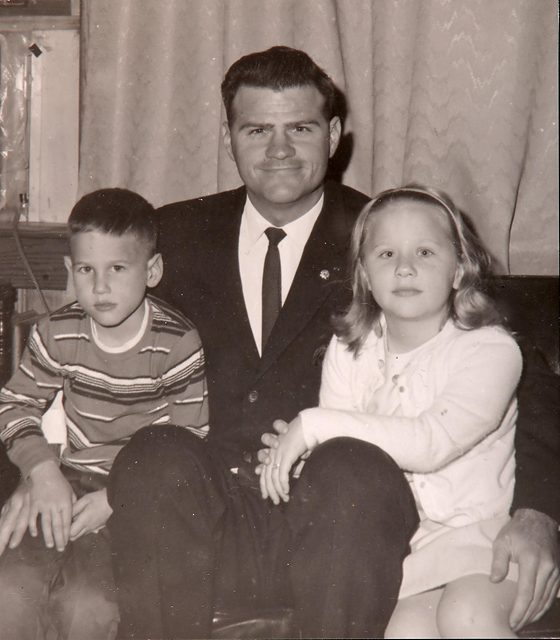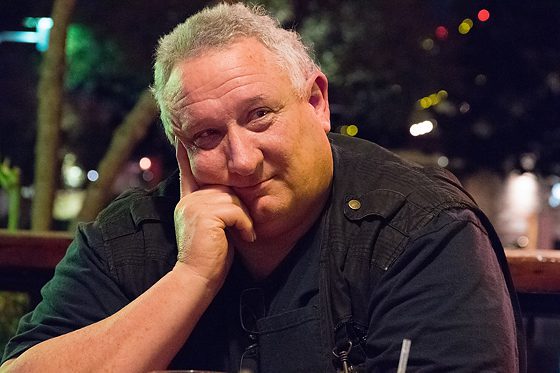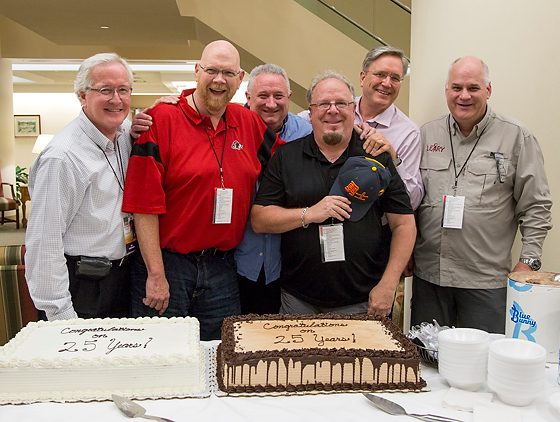Left to Right: Jim Veneman, Bob Carey, Morris Abernathy, Louis Deluca, Ron London, & [Me] Stanley LearyI apologize for the rambling below. It is a stream of consciousness of some of what I experienced this past weekend at the conference.

Twenty-five years ago, we didn’t have the ability to FaceTime with each other. We also didn’t have the power back in 1992 to shoot photos and share them instantaneously with each other.

I want to talk here about my journey through the years. When we started the SWPJC, I had not come to terms with my Autism. In third grade, I was tested and fell on the spectrum, but they didn’t give me the label back then.
I would slowly understand through many different events that I fit the Aspergers Syndrome perspective on the Autism Spectrum. Through the years, I have been taking steps like speech therapy and studying social work, which has helped me significantly improve my deficiencies.
This past weekend when I was teaching, I was reminded of my Autism.
I asked everyone in the class I was leading to take a picture. When asked what they took a picture of, I had people talk about taking a picture of me with a scowl on my face. Then a couple of minutes later, someone talked again about my body language as being negative.

I could have just crawled up into a ball and just cried. I realized that while I had done much through the years to pay attention to others, I had not done much to work on my facial expressions.
Autism is a developmental disorder involving qualitative impairments in social interaction. One source of those impairments is difficulties creating facial expressions of emotion. Difficulties with facial expressions may arise from deficits in motivation to express positive feelings with others. The tests may also stem from physiological problems in physically creating expressions due to damage to areas of the brain that control the facial nerve (which produces those expressions).
I know my family has really given me a hard time through the years when they take photos of me. I just don’t look happy. I guess there are moments when a glimpse of my enthusiasm does come through, but I cannot consciously bring the emotions I feel to my face.
I can tell you that I am always thinking and observing others. I do not take lightly those around me. I am always trying to figure out how to be of service. Can I help them, or what problem might they need help with? I often try to connect people with a need with someone I know that could be the solution. So my facial expressions are, I guess, accurate. I think which can produce a scowl or tense brow.
I want to be Helpful and Not Hurtful …
So that you may not be sluggish, but imitators of those who through faith and patience inherit the promises.
– Hebrews 6:12
I can tell you that God isn’t finished with me yet. I have a lot of work to do with my facial expressions. The good news is I know what I need to work on going forward.
… LORD, lift thou up the light of thy countenance upon us.
– Psalm 4:6

The Southwestern Photojournalism Conference started because Morris Abernathy called Jim Veneman and mentioned we had an opportunity to take over a photo workshop that Don Rutledge had held at the Seminary for years.
Morris’s vision was to expand the conference and make it an event where more people would feel welcomed. Morris has one of the biggest hearts for people that I know. He is also the one person who has had me doubled over in laughter where tears flow so many times. My wife and I think of the times we both have enjoyed his humor.
Morris has been a joy not just to me but to all who come into contact with him. We were blessed that he invested so much of his life into the conference.
Iron sharpeneth iron; so a man sharpeneth the countenance of his friend.
– Proverbs 27:17

Morris is the person who was leading all the rest of us, including everyone. This photo of Jim Veneman putting his arm around Akili Ramsess just after meeting her is indicative of the conference’s purpose. We were about to welcome everyone to the table.
While this was the purpose of the original group, I can tell you that through the years, it hasn’t gone well every time. You see, I know from personal experience that there are many other people out there like me. Their facial expressions and body language doesn’t always match their hearts.
I believe those who started the conference want to return to our core values and put some changes that will make this conference more as Morris Abernathy had envisioned.


An amateur (French amateur “lover of,” from Old French and ultimately from Latin amatorem nom. amator, “lover”) is generally considered a person attached to a particular pursuit, study, or science in a non-professional or unpaid manner. Amateurs often have little or no formal training in their goals; many are autodidacts (self-taught).

“The most powerful words ever said to you are your own,” said Garrett Hubbard. The self-talk we do can be the most damaging or uplifting. We are in charge of which that will be.
Garrett also talked about how we often limited our identity to our job title and encouraged us to see our whole selves.


While thinking and looking for ways to serve even more than I do now, Pat is buzzing by me like an Energizer Bunny in the commercial. He is beating his drum and pulling as many as possible behind him in his parade. Pat is the pied piper of photojournalism.
Before you know it, Pat has a group of students teaching them all about lighting.
By this everyone will know that you are my disciples, if you love one another.”
– John 13:35
The cornerstone of the conference is Jesus Christ. The thing that we try to do yearly is very similar to what a mason calls the “Holding Bond” – maintaining a plumb-aligned bond or brick pattern. To do this, a mason creates the “Hanging the line” – attaching a mason’s line to the leads at opposite ends of a wall.
The committee that produces the conference each year is taking the time to meet soon to retool the forum. We will be “Hanging the Line” so that we can be “Holding Bond” so that when people look at our conference, they will see the love we have for one another.
Stay tuned through our website SWPJC.org.




Brien Aho is helping one of the students with his Nikon 5300. The student asked me, but I knew Brien was more familiar with the camera as a Nikon representative. Whenever I turned around, I saw Brien helping people with cameras.


We are planning on getting our committee together to make a planning retreat for the conference. We have not done this before and believe this is what is needed to go forward for the conference to be successful. Ron London reminded us at the meeting to never stop being an amateur photographer. He went on to explain what the word amateur came from and means. Akili Ramsess, NPPA executive director, spent her presentation and every other opportunity to talk about our success is all about relationships. She also helped us to see that what NPPA is trying to do for photographers is help them have connections throughout the industry. Patrick Murphy-Racey thinks more like me than most of any of my other friends when it comes to photography. The most significant difference between us is that Pat’s enthusiasm and excitement are written all over his face.
If there is one photographer I am incredibly jealous of, it would be Pat. I am jealous of how he exudes excitement to others.
We just wrapped up our 25th Anniversary for the Southwestern Photojournalism Conference, and this is the original crew. I am not sure how long we thought this would go on when we started this adventure, but we all feel like it was just yesterday. The student workshop we added many years ago has been an enormous success. One of the main reasons is the ability of the students to shoot and show the instructors their work immediately for some feedback and the ability to go and reshoot if necessary.

